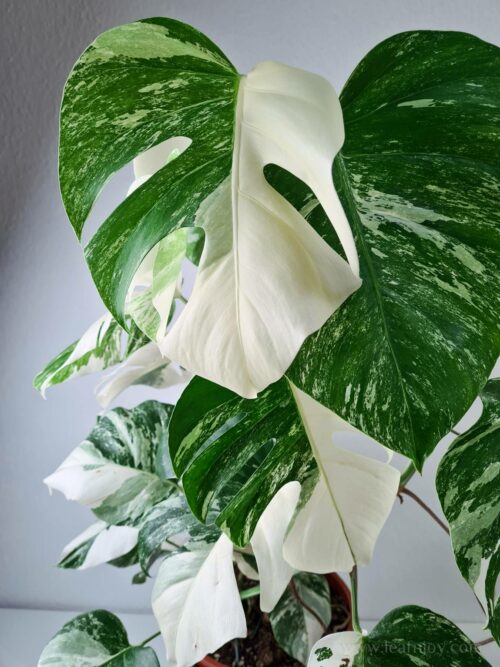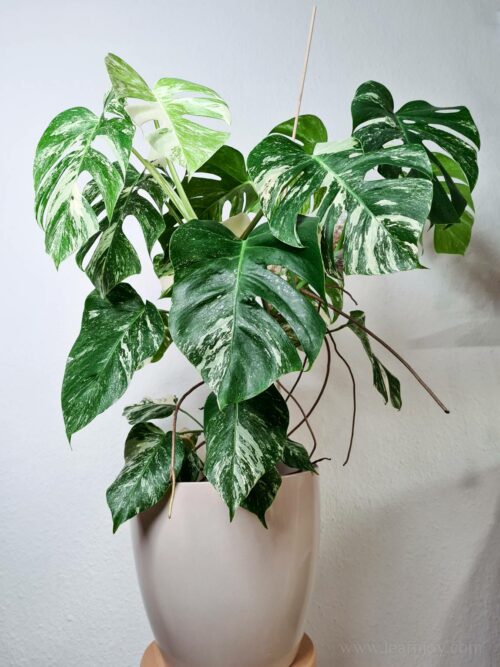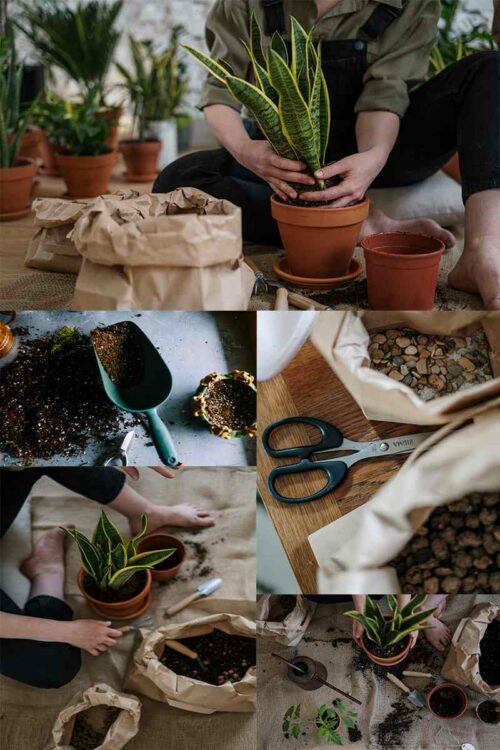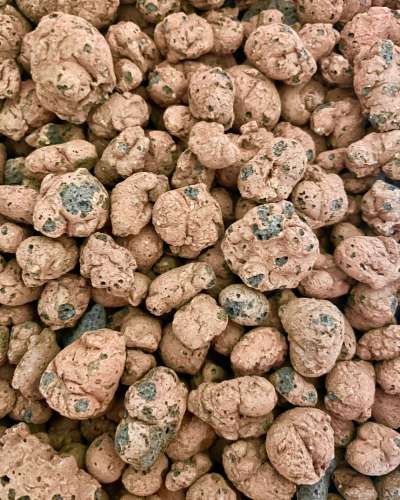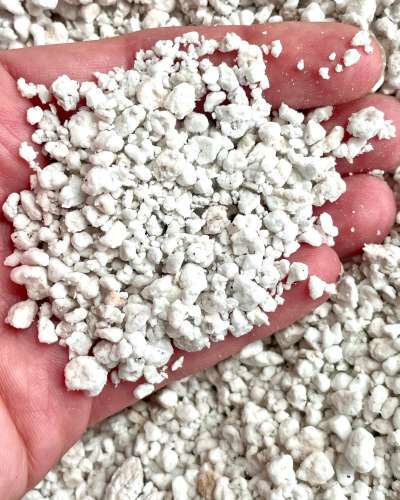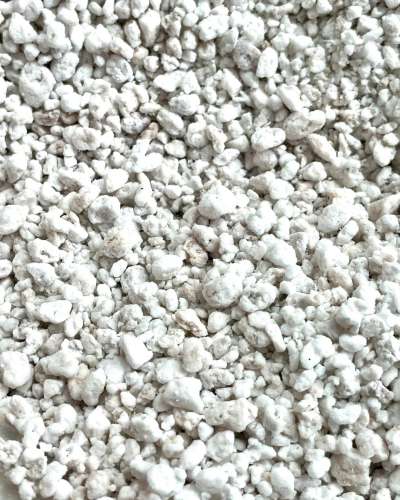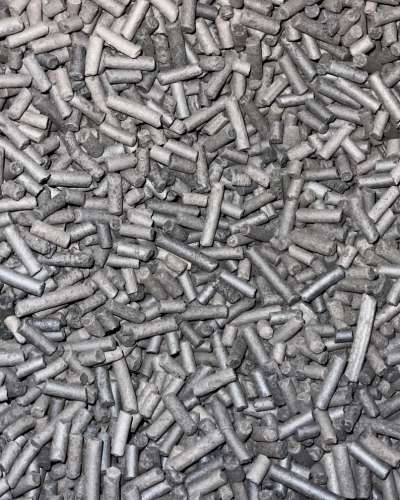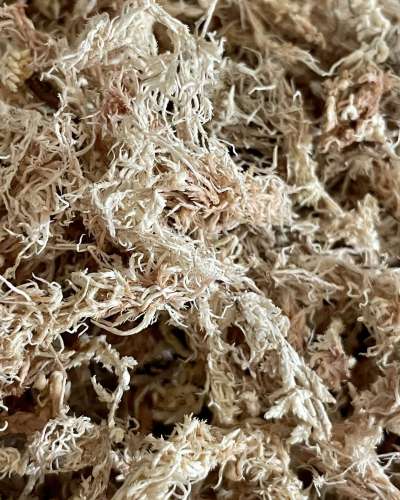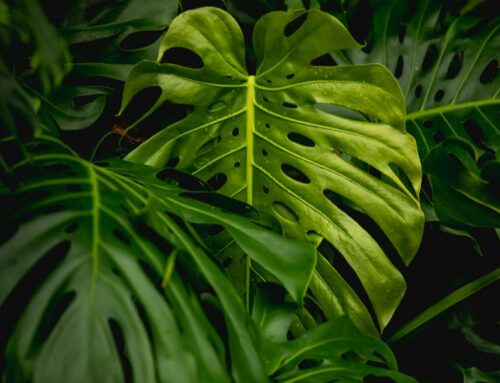How to care for a Monstera, can a Monstera live outside or in low light? How often do you need to water a Monstera?
These Monstera care related questions might be running through your mind if you recently bought a Monstera as a houseplant or are looking into getting one. I got you.
Monstera are incredibly easy to care for as they are low-maintenance houseplants. This complete Monstera care guide will cover everything important that you need to know to keep your Monstera continously growing and thriving.
This post may contain affiliate links. Read our Privacy Policy and Disclosure here.
But first a little bit of a background. What are Monstera plants, where do they come from and why is Monstera Deliciosa still the “It Plant”?
The plants from the Monstera genus are part of the arum family, consisting of 48 different flowering species. Although their foliage is toxic if consumed, the fruits are edible. For instance, the fruits produced by the Monstera Deliciosa are said to have a taste resembling a mix between pineapple and banana. Yum!
The Monstera Deliciosa is perhaps the most popular representative of the genus. This climbing evergreen perennial can grow up to an incredible 60ft (18 meters) in height in its natural habitat. Thankfully, grown as a houseplant, a Monstera would stay much more compact.
Monsteras are a stunning, tropical addition to any home and they are not too picky when it comes to their care routine, which makes them great plants even for beginners.
This article will provide you with detailed information about the care needs of a monstera (grown indoors) so that your aroid plant can grow lush, happy, and healthy.
How to Take Care for a Monstera – Basic Guidelines
You can find a summary of the care needs of a Monstera in the table below.
Common Names: The Swiss Cheese Plant (Monstera Adansonii), Split-Leaf Philodendron (Monstera Deliciosa)
Origin: tropical America
Light: bright indirect
Water: moderately
PH: 5.5 – 6.5
Repot: every 2 to 3 years
Temperatures: 18°C to 28°C (64.4 °F to 82.4 °F)
Humidity: 45% to 80%
Nutrition: balanced fertilizer (eg: 10-10-10) or 3-1-2 NPK (or similiar); simple NPK fertilizer isn’t enough so ensure that micro elements are also included
Fertilize: 2 times/year with slow release fertilizer or monthly with liquid one during the growing season; don’t fertilize if the plant is not actively growing
Propagation: stem cuttings, seeds (rarely)
Pests: scale insects, spider mites and thrips
Toxic? Yes, if ingested.
Continue reading for a detailed guide on how to care for a Monstera as a houseplant.
Monstera Plant Care: Overview
Are Monstera easy to care for and are they beginner-friendly plants? Absolutely! The majority of the Monstera genus, especially Monstera Deliciosa, are easy to care for, are tolerant of being neglected at times, and can grow huge, lush leaves that put everyone in awe.
Monstera are considered low-maintenance houseplants and can survive in different environmental conditions. If their needs have been met, Monstera are moderate to fast growing plants. So if you want your Monstera to thrive, be happy, healthy, and constantly growing, then read on.
There are multiple factors contributing to the health and development of any Monstera. Light and water are the two most important care requirements to keep in mind and get them right, as the majority of issues when it comes to Monsteras are as a result of overwatering or inadequate lighting.
1. How much light a Monstera plant needs?
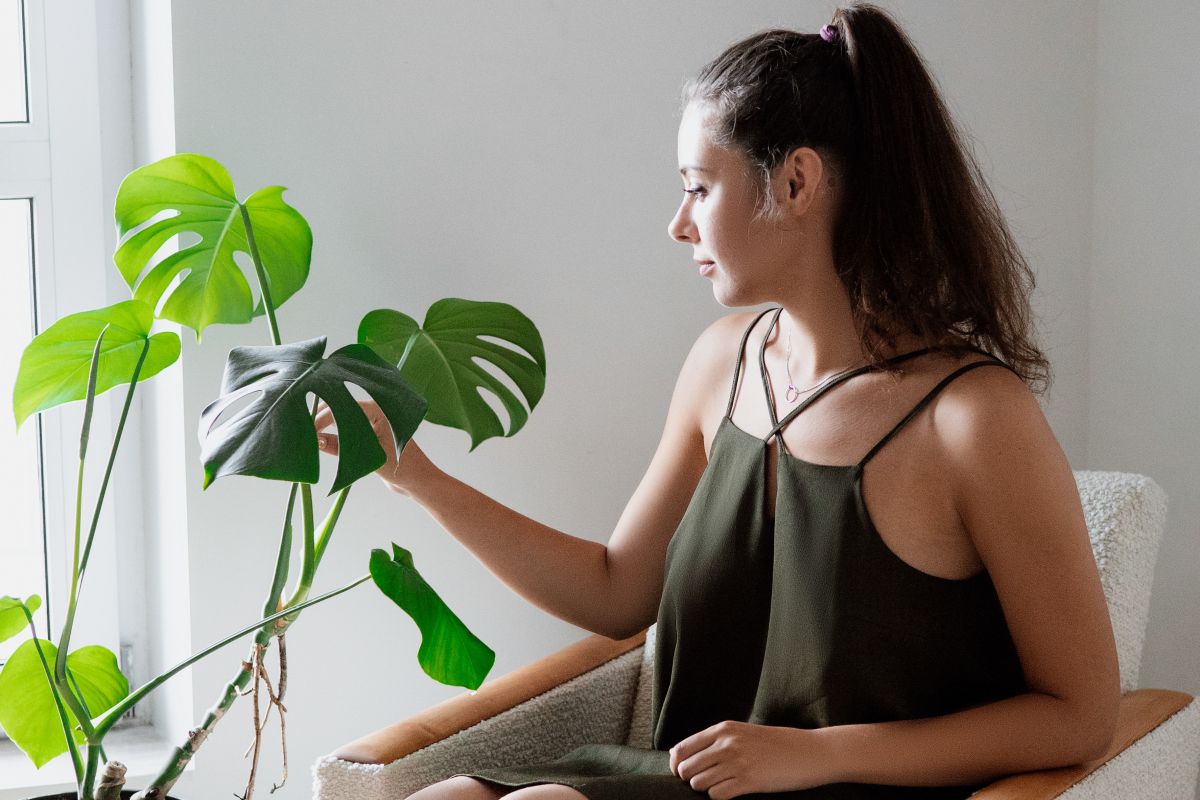
Monstera will appreciate all the light it can get. Not only does light support and boost the growth of a Monstera, light is also vital for getting larger and more fenestrated leaves. So whenever possible, place your Monstera in a location that is receiving bright, indirect sunlight. However, make sure to protect your Monstera plant from any direct and harsh sunlight exposure as the leaves might get scorched.
Generally, a Monstera will thrive when placed close to a west-facing window or close to a south-facing one with the light being diffused (by a curtain, for instance). Don’t forget that factors such as window direction, time of the year, obstacles in the way of light and how close you are to the equator, will all affect the strength of natural sunlight that is coming through your windows. For instance, in winter, you might need to consider a grow light for your Monstera to meet the plant’s needs.
Can a Monstera grow in low light? A Monstera can survive in full shade but the plant will not grow well. However, the good news is that Monstera can grow under artificial light. So if a low light spot is the only thing that you can offer to your Monstera, consider investing in artificial lights, for example, a full-spectrum grow light.
How much light (PAR) do Monstera need? For optimum growth, the PPFD for a Monstera grown indoors should be 100-350 umol/m2/s with a lighting period of 12 to 14 hours per day.
How much lux (foot candles) do Monstera plants need? For plant maintenance, aim to provide your Monstera with 1 000 lux (100 foot candles), however, for optimal growth, your Monstera plant should receive 4 000 lux (400 foot candles).
Are you wondering how to measure the lux number or the PPFD of a light source? Use a light meter (lux meter). Alternatively, download a smarphone app that might be able to provide you with accurate results.
Note: If your Monstera grows outside, make sure that the plant is placed under a larger tree or under an overhang, so that the rays from direct sun won’t scorch the leaves.
2. How often to water a Monstera?
Improper watering is one of the main causes of health problems when it comes to houseplants. Plants that are experiencing water stress are more vulnerable to pest infestations and infections.
A Monstera will not tolerate wet feet nor being bone-dry for long. Watering your Monstera on a fixed schedule might also not work as the temperatures, humidity, and light levels change constantly. For instance, at lower temperatures and lower light conditions, your Monstera will need to be watered less often compared to during the summer season.
Depending on what medium you use for your Monstera, a moisture meter might come in handy. However, there is even a better and more accurate method. Your index finger. With the tip of your finger, inspect the top 2-6cm (0.5-2 inches) of the soil, if it’s dry – water your plant thoroughly (a.k.a. you always want to ensure that you water your plant until water starts dripping from the drainage hole). If upon inspection, the soil is still moist – check again in 3-5 days. Note: the larger the pot, the deeper you would want to check with your finger for moisture of the soil.
Another way is (if physically possible as we all know how huge Monsteras can become!) to just lift the pot and based on the weight decide whether it is time for watering or not just yet. Tip: ideally, you would first make a note of how heavy a watered pot is as compared to a dry one, as some pots can be naturally quite heavy (eg: terracotta or ceramic pots).
Are you over-watering your Monstera? A sure sign that you are overwatering your Monstera is the development of brown spots around the edges that have a yellow halo that later becomes brown as well. Another tell-tale signs of an overwatered Monster is yellowing leaves. Usually, you would just need to skip watering your plant for a week or so, and it should stabilize. For more extreme cases, where the situation is suggesting root or stem rot, measures need to be taken at once. Suspecting that your Monstera is suffering from root rot? Make sure to check our very detailed guide on how to spot rot in time and how to treat it before it overtakes your plant.
Monsteras definitely dislike having wet feet so it is really important to not over-water your plant, better be safe and keep it on the more dry side than sorry. Please note: Monsteras are usually acting tough at first so signs of over-watering can appear even a month later.
Signs that a Monstera is under-watered: Monsteras need a lot of water to get those beautiful and huge leaves up, so if you see that the leaves of your plant are not standing up and are drooping or if the stem of your Monstera looks a bit wrinkled, chances are that your darling could use a good drink. Another tell-tale sign of an underwatering issue is stunted growth and die-off of a new growth.
3. What is the best potting mix for a Monstera grown as a houseplant?
A well-draining but moist-retaining aroid potting mix is what your Monstera will love. We highly recommend investing in well-balanced potting soil for your plant that has been specifically tailored to aroid plants. And to make things easier for your and your plantie, we have just the right potting mix for your Monstera in our shop, yey! Time to grow.
Alternatively, if you would like to make your own potting mix for your Monstera equal parts of perlite, high-quality potting soil, and bark will do it.
Another thing to mention is that the pot that you chose for your Monstera can make all the difference. Unglazed clay pots, or in other words, terracotta pots are amazing for this tropical plant as they allow the roots to breathe much much better compared to plastic pots. So say no to plastic, and yes to clay when it comes to choosing a pot for your indoor Monstera beauty.
Can you grow Monstera plants in hydroponics or semi-hydroponics?
Interesting to consider: Monstera can grow in water and can be adapted to live a life as water-based plants. Apart from that, you can also grow a Monstera succesfully in hydroponic environment, for example: by using LECA (expanded clay balls), pon or sphagnum moss. Just make sure to adapt your Monstera fertilization schedule accordingly.
4. How often does a Monstera need to be fertilized?
Using a fertilizer regularly will help your Monstera to produce bigger and more lush leaves. Keep in mind, that a simple NPK fertilizer will not be enough, so make sure that the fertilizer of your choice contains micronutrients as well.
Most fertilizers consist of three main minerals which are important nutrients for the plants’ growth: nitrogen, phosphorous and potassium.
Long story short: different types of plants need a different ratio of these nutrients. Therefore the nutrition-ratio is listed on the bottle of commercial fertilizer. The composition is usually communicated in form of % values (i.e. 1,9% phosphorous) or a as ratio (i.e. 2-1-2 for N-P-K)
You can use a balanced fertilizer (for example, 10-10-10 or 20-20-20) for your Monstera or one that is suitable for green leafy plants and has the following NPK ration (or similiar) 3-2-1. Both slow-release fertilizer and a liquid one will work well for a this tropical plant. Fertilize your Monstera 2 times per year with a slow-release fertilizer: once in early spring and once in mid summer, and follow the manufacturer’s instructions for application.
Alternatively, if you opt to use a liquid fertilizer for your Monstera, you can feed your plant approximately every month or so (or as indicated) during the growing season. Don’t fertilizer your Monstera when the plant is not actively growing (during the winter months from October to March). If you are using a liquid fertilizer for your Monstera, adjust the pH of the water (after adding in the fertilizer) to 5,8-6,2. This pH range will ensure that your Monstera absorbs nutrients optimally. You can measure the pH value by using a pH meter.
Our preference: the “weakly weekly” fertilization method. When it comes to Monsteras, we prefer a “weakly weekly” feeding compared to a single high-dose fertilizer once per month. The “weakly weekly” method is also much gentler on the roots and lowers the risk of fertilizer burn. With this fertilization technique, we feed our plants every week with approximately only 15-25% of the recommended fertilizer’s dose for 3 weeks during the month, followed by flusing them using clean water. During the months of active growth (March to October), you should aim to fertilize your Monstera regularly and hold off on fertilizing (or considerably lower the frequency) during the months of October to February unless your plant is still actively growing.
5. How much humidity does a Monstera need?

Even though in nature Monsteras grow in humid conditions, they can also adapt and survive at normal room humidity, especially if it is a Deliciosa or an Adansonii (Epipremnoides and Monstera Obliqua are a bit more problematic and require constant humidity levels of 65%+). You can measure the humidity in a room by using a hygrometer.
So even though a bathroom or a kitchen would be the ideal room to grow your Monstera in, there is no need to limit yourself. As long as a Monstera gets used to its environment, wherever you place it, it will be fine there. So in short: a humidifier is not always a must for Monstera plant parents.
However, these tropical plants that are incredibly adaptive to different humidity environments need one thing: stability. Sudden drops in humidity might be problematic for a Monstera. This is mostly the case during Winter times when heaters are being used to warm up a room. Make sure that all of your plants are placed away from any direct exposure to heaters. Brown, dry edges on the leaves are a sure sign that the humidity is too low. Yellowing and loss of colour of the foliage of a Monstera is another sign of low humidity.
If you are noticing that your plants are showing signs of stress due to low humidity, consider getting a humidifier. Most of your houseplants will for sure appreciate the extra effort!
6. Can a Monstera Live Outside?
Yes, your Monstera can live outside, just make sure to bring the plant in for the winter once the temperatures in your region start dropping below 10°C (50°F).
Protect your Monstera from any extreme weather conditions. The plant will not tolerate low temperatures for too long: temperatures below 10°C (50°F) will make the plant stop growing and temperatures below freezing can potentially kill your plant, so if you have a Monstera growing outdoors and the temperatures start dropping, it is a good time to take it inside for the Winter. Monstera can be tolerant towards the following temperature range: 10°C to 38 °C (50 °F to 100 °F). However, it is not advisable to grow your Monstera in these extremes.
The best temperature ranges to grow Monstera are between 18°C and 28°C (65°F to 85°F).
Remember how I said that Monsteras love a stable environment? Huge temperature differences are to be avoided whenever possible as they are stressful to the plants and can cause physiological distress.
7. Climbing Support for Monstera
Staking, aka climbing support is a must-have if you have a Monstera unless you want the plant, you know, growing on the floor and sort of everywhere.
Is your Monstera leaning towards one side more than the other and looks as if it is growing horizontally rather than vertically? Monstera plants are natural climbers, so they would absolutely appreciate some climbing support. Or else, they will just climb on whatever they can get their “hands on”. So consider treating your Monstera with a coconut coir.
Staking your Monstera is a great way to influence the way and direction of where the plant grows. Not to mention, providing your Monstera with climbing support can positively affect the growth speed, the size of the new growth and surprise, surprise: the fenestration!
So if your baby Monstera is long past the baby stage by now, it is time to stake away – you and your Monstera will love it.
8. How to repot a Monstera
Repotting your Monstera is not always needed, unless your plant is root-bound or you suspect a root problem. If you want to know what are the signs that your Monstera is root bound or is suffering from root-rot, read this article.
Generally, a Monstera Deliciosa (and the rest) would need to be repotted every 2-3 years. This can differ from plant to a plant depending on how fast is your Monstera growing.
The best time to repot your Monstera is during the growing season from spring till fall. And if you have decided to move your Monstera to a new pot – choose the next size pot for it and not 5 sizes bigger. If the pot is too big for your Monstera, you run the risk of overwatering it.
Be gentle with the root ball of your Monstera when you are repotting. You can shake excess old soil by gently tapping the root ball. It is not a must to remove all the soil from the roots, so rather plant your new darling with a bit of old soil instead of ripping off chunks of roots.
Make sure that you always use a well-draining potting mix for your Monstera, such as one suitable for aroids.
Extra tip: Don’t repot a new arrival too soon. If your plant has just arrived – allow it to rest and recover for at least two weeks before repotting it.
9. How to get fenestrated leaves on a Monstera

Is your Monstera growing but the leaves are just not getting bigger and the fenestration is either nowhere to be found or is decreasing? If the leaves of your Monstera are not splitting, it could be that the plant is either not receiving enough light or it is low on nutrients. The fenestration of a Monstera depends on the age of the plant, on the light conditions, and on the nutritional uptake of the plant. Hence, consider investing in a grow light and grab a fertilizer for your beloved aroid plant.
10. How to Propagate Your Monstera
The most common way of propagating a Monstera is through taking stem cuttings, nursing them till they root and then transplanting them to bigger pots.
Monsteras can also be propagated through division, but this is usually not so easily done as it is hard to separate the roots of a plant that has multiple growth points (or crowns) underground. If you are still wondering if you should attempt to propagate your Monstera through division, here is a detailed article.
Seed propagation of Monsteras is also rare as the plants take approximately 3-5 years to reach maturity and to start producing fruits. The fruits, themselves, take the wooping 10 months to ripe, and a Monstera seedling would mature slower compared to a Monstera grown from a cutting.
Air layering is a great propagation technique that can be used to propagate a Monstera. Air layering involves rooting the baby plant while it is still on the mother plant. To air layer a plant: locate a node and wrap it in sphagnum moss while keeping it moist but breathing. It sort of looks like a little pamper on your plant. In about a month you should see new roots starting to form in the sphagnum ball that you just created. After the roots have formed well, you can separate your baby plantie from the mommy by cutting the stem below the roots. That’s it! Now you can pot your new Monstera.
If you don’t want the extra hassle due to air layering, then propagating your Monstera through stem cuttings is your best-bet to get more of these plants for free. Did someone say Monsteras for free? Let’s go.

So what are the things that you might want to keep in mind to propagate your Monstera successfully?
First and foremost, you should attempt to propagate your Monstera only when the plant is actively growing, i.e. from spring till fall. Unless you’re dealing with an emergency (eg: the stem snapped or it is a disease issue), you shouldn’t try to propagate your Monstera plants while it is dormant as this lowers your chances of successful propagation.
Once Spring knocks on your door and you are confident that you want to propagate your Monstera, it’s time to take some cuttings and decide on how are you going to root them.
How to take stem cuttings from a Monstera?
Ideally, your Monstera cuttings will have at least 2 nodes and 2 leaves. You should cut your mother plant just below a node on the stem. Make sure you are using a sharp knife/shears/ something sharp that has been properly disinfected – i.e. use at least 70% rubbing alcohol. Let the cutting place dry and callus for at least 1-2 hours before proceeding with the propagation.
There are different ways to root your Monstera cuttings. You can root them by planting the cuttings directly in a sterile soil mix (keep it moist, not drenched), putting them in a mix of sphagnum with perlite (remember: moist, NOT drenched), using semi-hydro media (perlite or expanded clay pebbles – LECA) or simply placing them in a jar with rain or distilled water and change the water every couple of days or so. After the cuttings have developed substantial roots, you can transfer them to the growing medium of your choice or… you can continue growing your Monstera hydroponically.
Bear in mind one thing, however. Water roots are NOT soil roots. Those are different than soil (and aerial roots). Hence, if you opted to root your Monstera in water and then decided to transfer it to potting soil, except the plant to experience an initial shock when moved to a different growing media and some roots might be lost white the plant adapts to life in soil.
How long does it take for a Monstera cutting to root? It depends. Some Monstera cuttings root within 10 days while others take their time and only after 4 months, finally form roots.
The last thing to keep in mind and this is important: keep your cutting in a bright and warm location with sufficient air circulation. These three are a must.
Stem rot is one of the most common issues while propagating a Monstera from a cutting. Stem rot can be managed and treated successfully if caught enough early on. That’s why, make sure to read our detailed article about how to recognise and treat stem rot, to give your cutting a fighting chance.
Let’s make a final point very clear: you can’t propagate a Monstera from a cutting without a node.
NB: What parts of a Monstera plant cannot be propagated, i.e. a new plant will NOT grow from:
- a stem cutting without a node
- a leaf without a stem
- an aerial root without a node (i.e. do not just cut off a section of the stem where you see an aerial root – you NEED a node)
- basically, everything without a node is a no-go.
11. Foliage maintenance – Keep your Monstera’s Leaves Dust-Free

Monstera plants can quickly collect dust on their foliage. This, in turn, does not allow the plant to fully photosynthesize as it should. In the jungle, the leaves are getting regularly washed by the rain. So if your plant is small enough to be moved, we would recommend giving it a good shower when you see that the leaves are getting dusty. Showering your Monstera once per month should be sufficient for most households. Alternatively, if you have a huge Monstera that is just too big to be moved, wiping the leaves off with rainwater/distilled water and a clean towel (or a soft brush) regularly will do the trick.
Keeping your Monstera’s leaves dust-free also discourages pests from finding your plant attractive, especially spider mites love to dance on top of dirty leaves. So to avoid the mites, clean those leaves!
12. Monstera Variegata Care
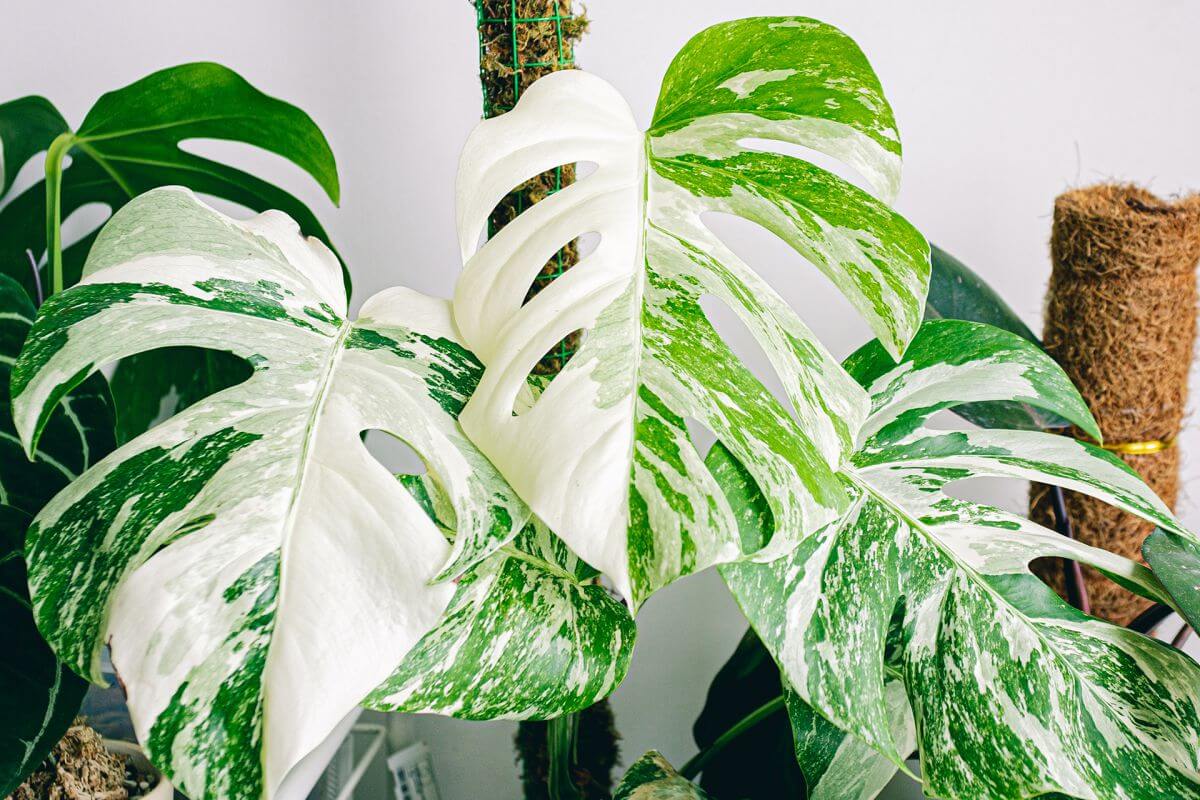
Do you have a variegated Monstera and are struggling with brown spots on the leaves? It’s common as variegated plants are more fragile and would should sign of distress faster than fully green ones.
In general, variegated plants need more light to sustain themselves than their non-variegated cousins. So if your Monstera Variegata is throwing a tantrum by turning its white parts brown, investigate what care requirements might not have been met.
Once again, the most common reason why the variegated parts on your Monstera are turning brown is inadequate light. The second most common reason is inadequate watering routine. If the spots start developing inside of the leaf and appear wet – it is probably an overwatering issues.
If the spots on your Monstera Variegata are starting from the tips of the leaves and appear dry and crispy – it is most likely an underwatering issue or a humidity issue.
Correct the environmental conditions around your variegated Monstera and see if the plant will feel better. The brown spots on variegated foliage are in most cases not harmful to the plant itself, but of course, if they are visually bothering you – you can trim them off. Just make sure that you are using a disinfected cutting tool and are not cutting into healthy leaf tissue.
13. What to do with the aerial roots of a Monstera
Monstera Deliciosa, especially, is notorious for producing aerial roots that seem to be crawling everywhere they can get their ‘hands on’. The best thing you could do with those sometimes really huge and long aerial roots of a Monstera is to gently direct them into the soil. There they will start transforming into soil roots, aka the plant will be able to absorb nutrients even better which equals better plant growth.
14. Regularly inspect your plants for pests
Monsteras are quite resilient plants. They are easy to take care of but sometimes, they too get visited by pests. Bummer, I know!
Occasionally, you might find that your Monstera is having unwanted visitors. Prevention is always the key to not having a pests infestation but sometimes, it is just unavoidable. This is why a great habit to develop as a plant parent is to inspect your plants at least every 7-14 days thoroughly for any buggers. At first sign of a pests infestation on a Monstera: measures should be taken immediately. And don’t panic if you notice something crawling on the leaves of your aroid plant: pest problems are very manageable if caught early! For treatment we recommend to isolate the affected plant(s) to prevent spreading and use an organic insecticidal pesticide (for example alcohol, soap, neem oil or home-made tinctures). Repeat when necessary.
Thrips are the main party-crashers attacking Monsteras. You might find an occasional spider mite but they are much less common. Aand… because you are not keeping the soil consistently moist (and you shouldn’t), fungus gnats are also not usually a problem. My honest advice: if you have a Monstera, always and I mean always, be suspicious of thrips.
15. Common Care Issues with Monsteras
You will notice if your Monstera is not feeling particularly well by the appearance of dull or yellow leaves.
A single yellow leaf is completely normal but if your Monstera suddenly starts loosing vigour and leaves start drooping, it could be that the environment around your Monstera is not ideal for it. Most often than not, spots and yellow leaves on foliage are caused by not meeting a plant’s requirements.
If your Monstera houseplant suddenly starts deteriorating fast, the issue could be a more serious one, in which case the plant might be suffering from stem or root rot. Rot spreads fast and can quickly lead to the death of any plant. It is a grim situation, I know, however, even if your Monstera is dealing with a rot-related issue, you can absolutely save your beloved green darling as long as you act fast and stay on task.
On the other hand, however, there are also the fungal diseases such as Rust fungus. To prevent fungal diseases on the foliage, avoid misting your Monstera, especially during the colder seasons where the plant might not be receiving enough hours of daylight for the leaves to dry fast enough. However, fungus can spread fast as their spores are light enough to travel through air and water-droplets, so if you suspect that your Monstera might have a fungal issues, isolate it from the rest of your plants immediately and apply an appropriate fungicide. In certain cases, you might need to remove affected leaves on your Monstera, if the plant has enough foliage to sustain itself.
16. Can you grow Monstera in a Terrarium?
The short answer is: maybe. Whether you can grow successfully your Monstera in a terrarium would depend on the type of Monstera that you have and on the size of your terrarium. For example, Monstera Deliciosa are probably not the most suitable plants to be grown in a terrarium, but their smaller sisters: Monstera Adansonii and Monstera Tetrasperma (also called “Mini Monstera” or “Monstera Minima”) can be grown in a terrarium.
If you decide to try to grow your small Monstera in a terrarium versus the usual pot, we have a DIY Terrarium Set that includes substrates that you would need to make things easer.
On the other hand, if you are just getting started with growing plants in a terrarium, Succulents & Cacti might be a better choice for beginners.
17. Are Monstera Leaves Toxic?

The leaves of a Monstera (and of other aroid plants, i.e. Araceae family) are toxic as they contain calcium oxalate crystals which are known to be irritants. As a result, Monstera’s leaves shouldn’t be ingested. The toxin can cause symptoms such as vomiting, swollen parts in the oral cavity, excessive salivation, and stomach spasms. However, the good news is that generally, no long-term health side effects have been observed.
Your Monstera is not pet-friendly! And when I say Monstera, I mean all Monstera plants are toxic to humans and pets alike, eg: Monstera Adansonii, Monstera Deliciosa, Monstera Obliqua, etc. Keep your Monstera away from any pets or small children that might be intrigued to give the leaves a little try by placing it in a high enough position for no one to reach.
Monstera Care: Final Thoughts
In this care guide, multiple aspects of how to care for Monstera grown indoors were covered. Monsteras are low-maintenance plants that will thrive when provided with a bright location, moderate amounts of water, and some love. They are plants that can adapt to different environmental conditions, which makes them suitable for almost any home. And let’s not forget, the fenestrated foliage of a Monstera makes the plant like no other.
Even though there are some demanding Monstera plants (Obliqua, I’m looking at you!), the majority of the Monstera genus make excellent houseplants for beginners. In particular, Monstera Deliciosa is a great plant for someone who is just starting their gardening journey.
I hope that this detailed Monstera care guide was able to answer any questions you might have about the growing requirements of the these gorgeous tropical plants. I absolutely love Monsteras, they are the perfect combination of low-demanding plants with a visually high impact on everyone.


